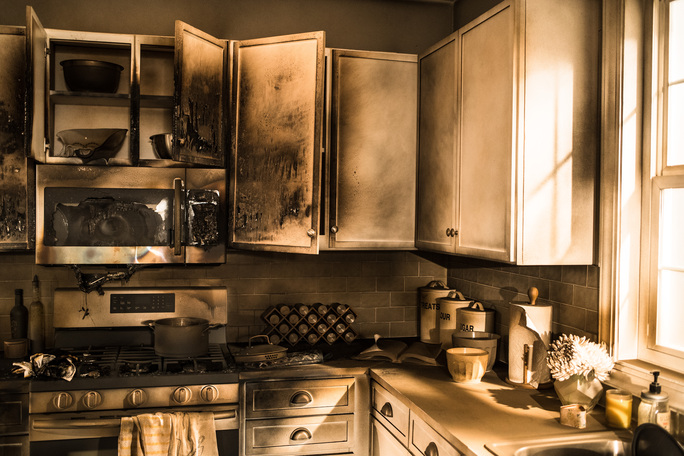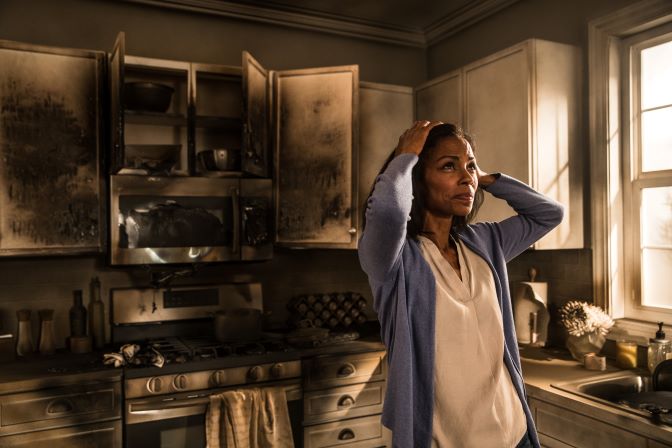Fire Prevention Week is observed every week of October 9th in order to raise awareness about fire safety and decrease the damage and casualties caused by fires. According to a report by the U.S. Fire Administration (USFA), cooking was the leading cause of all residential building fires and injuries from 2014 to 2016. In addition, it was also reported that “oil, fat and grease (47 percent) were the leading types of material ignited in nonconfined cooking fires in residential buildings.”
However, not all cooking fires are the same, nor are the damages they cause. In observance of fire safety, ServiceMaster by Wright will discuss the steps to remove cooking grease after protein fires.
What is a Protein Fire?

Protein fires, as the name implies, happen when food or products that contain protein are burned, such as meat, poultry, fish, and eggs. While protein fires do not always cause significant flames or emit a dark, heavy smoke, the harm lies in the layer of cooking grease left behind and the foul odor that is difficult to mitigate. This repugnant smell can quickly coat and permeate your kitchen walls, furniture, and cabinets, so there is a need to have it removed properly by a professional smoke and odor removal company in Florida.
How Do I Remove Cooking Grease after a Protein Fire?

Supplies Needed
- Floor covering
- Ladder
- Bucket
- Warm water
- White Vinegar
- Liquid dishwashing soap (not detergent)
- Sponge/sponge mop
- Soft brush
- Paint (for touchups)
Instructions:
- To prevent incurring more damage, cover the kitchen floor with plastic or old towels.
- Mix 2 tablespoons of vinegar and a squirt of dishwashing soap per quart of warm water. Use a bucket for this mixture.
- Submerge a sponge or sponge mop into the cleaning solution and wring out excess liquid.
- Using the sponge, gently scrub the countertops, cabinets, walls, and ceilings in a back-and-forth motion. For areas covered with grease, use a soft brush. Do this thoroughly to completely remove the smell and clean all surfaces.
- After scrubbing, rinse your sponge and throw the used water outside. Proceed to fill your bucket with clean, warm water.
- With the clean water and a clean rag or sponge, remove any residue of the previously used cleaning solution.
- Remove the plastic or old towels used to cover the floor. Give the floor a good scrubbing.
- Dry all surfaces completely and wait for the professionals to arrive if the odor remains. If there are persistent stains, cover them with a fresh coat of paint. However, this step should not be done if not all odors have been removed.
How Do I Prevent Protein Fires?
Luckily, there are steps that could minimize the chance of a protein fire. A homeowner should:
- Monitor food and equipment when cooking.
- Keep a fire extinguisher in the kitchen.
- Use a stovetop splatter guard to prevent grease from sticking or staining surfaces.
Check ServiceMaster by Wright‘s blog for more fire information, cleanup tips, and other ideas that will help keep your home healthy and your family safe from fires.
Protein fires has challenging consequences, so only call a trusted fire damage removal and repair company like ServiceMaster by Wright to take care of the damage in a professional way. As an IICRC-certified firm, ServiceMaster by Wright has skilled, well-trained, and experienced technicians that can deal with the damage and execute fire damage repair efficiently and effectively.
With over 40 years of experience in restoring homes and businesses due to disasters, ServiceMaster by Wright can provide the guidance, expertise and personalized care needed to make sure life gets back to normal as quickly as possible.
Call 239-431-9947 for smoke, soot and odor removal in Bonita Springs, Bradenton, Cape Coral, Englewood, Estero, Fort Myers, Lehigh Acres, Longboat Key, Naples, Marco Island, Port Charlotte, Punta Gorda, Sarasota, Siesta Key, and Venice, Florida.





